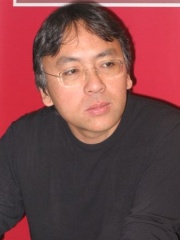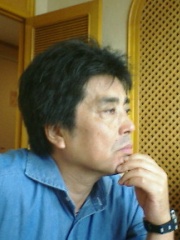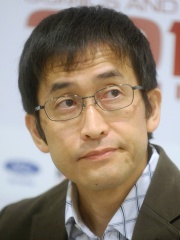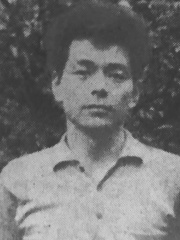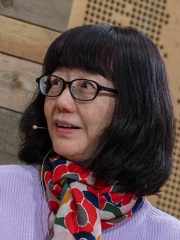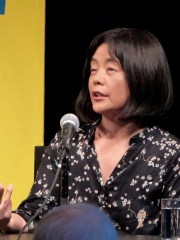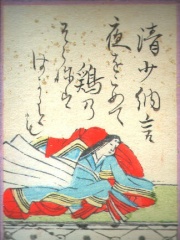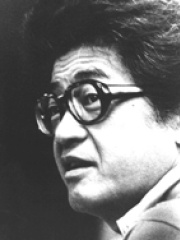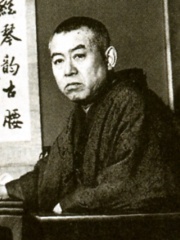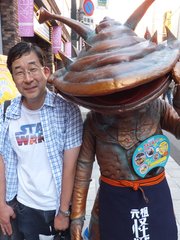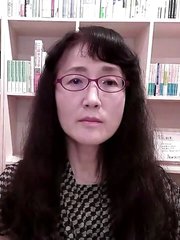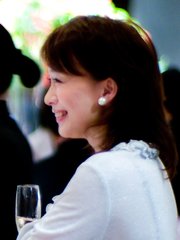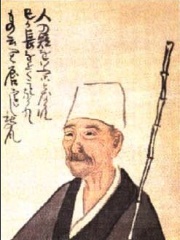
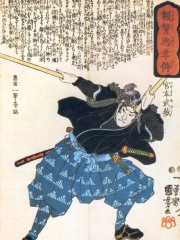
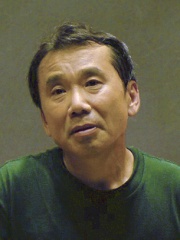
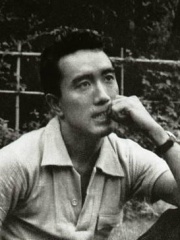
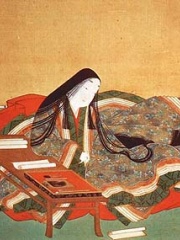
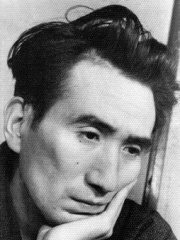
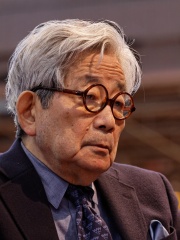
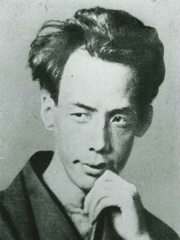
The Most Famous
WRITERS from Japan
Top 10
The following people are considered by Pantheon to be the top 10 most legendary Japanese Writers of all time. This list of famous Japanese Writers is sorted by HPI (Historical Popularity Index), a metric that aggregates information on a biography's online popularity. Visit the rankings page to view the entire list of Japanese Writers.

1. Matsuo Bashō (1644 - 1694)
With an HPI of 85.14, Matsuo Bashō is the most famous Japanese Writer. His biography has been translated into 163 different languages on wikipedia.
Matsuo Bashō (松尾 芭蕉; Japanese pronunciation: [ma.tsɯ.o (|) ba.ɕoː], 1644 – November 28, 1694); born Matsuo Kinsaku (松尾 金作), later known as Matsuo Chūemon Munefusa (松尾 忠右衛門 宗房) was the most famous Japanese poet of the Edo period. During his lifetime, Bashō was recognized for his works in the collaborative haikai no renga form; today, after centuries of commentary, he is recognized as the greatest master of haiku (then called hokku). He is also well known for his travel essays beginning with Records of a Weather-Exposed Skeleton (1684), written after his journey west to Kyoto and Nara. Matsuo Bashō's poetry is internationally renowned, and, in Japan, many of his poems are reproduced on monuments and traditional sites. Although Bashō is famous in the West for his hokku, he himself believed his best work lay in leading and participating in renku. As he himself said, "Many of my followers can write hokku as well as I can. Where I show who I really am is in linking haikai verses." Bashō was introduced to poetry at a young age, and after integrating himself into the intellectual scene of Edo (modern Tokyo) he quickly became well known throughout Japan. He made a living as a teacher; but then renounced the social, urban life of the literary circles and was inclined to wander throughout the country, heading west, east, and far into the northern wilderness to gain inspiration for his writing. His poems were influenced by his firsthand experience of the world around him, often encapsulating the feeling of a scene in a few simple elements.

2. Miyamoto Musashi (1584 - 1645)
With an HPI of 81.76, Miyamoto Musashi is the 2nd most famous Japanese Writer. His biography has been translated into 73 different languages.
Miyamoto Musashi (宮本 武蔵; Japanese pronunciation: [mʲi.ja.mo.to (|) mɯꜜ.sa.ɕi], c. 1583 – 13 June 1645) was a Japanese swordsman, strategist, artist and writer who became renowned through stories of his unique double-bladed swordsmanship and undefeated record in his 62 duels. Miyamoto is considered a kensei (sword saint) of Japan. He was the founder of the Niten Ichi-ryū (or Nito Ichi-ryū) style of swordsmanship, and in his final years authored The Book of Five Rings (五輪の書, Go Rin No Sho) and Dokkōdō (獨行道, The Path of Aloneness). Both documents were bequeathed to Terao Magonojō, Miyamoto's most important student, seven days before Musashi's death. The Book of Five Rings focuses on the character of his Niten Ichi-ryū school in a concrete sense; his own practical martial art and its generic significance. On the other hand, The Path of Aloneness deals with the ideas that lie behind it, as well as his life's philosophy in a few short aphoristic sentences. It is widely thought that both scriptures were to have been scheduled for burning due to a report from one of Musashi's disciples Furuhashi Sōzaemon who is said to have written about Musashi ordering his work to be burned; "There are no written works in my school". It is believed that Miyamoto was a friend of Mizuno Katsunari, a Tokugawa shogunate general. They fought together in the Battle of Sekigahara, Siege of Osaka, and Shimabara Rebellion as part of the Tokugawa Army. The Miyamoto Musashi Budokan training center in Ōhara-chō (Mimasaka), Okayama Prefecture, Japan, was erected in honor of him.

3. Haruki Murakami (b. 1949)
With an HPI of 80.40, Haruki Murakami is the 3rd most famous Japanese Writer. His biography has been translated into 95 different languages.
Haruki Murakami (村上 春樹, Murakami Haruki; born January 12, 1949) is a Japanese writer. His novels, essays, and short stories have been best-sellers in Japan and internationally, with his work translated into 50 languages and having sold millions of copies outside Japan. He has received numerous awards for his work, including the Gunzo Prize for New Writers, the World Fantasy Award, the Tanizaki Prize, Yomiuri Prize for Literature, the Frank O'Connor International Short Story Award, the Noma Literary Prize, the Franz Kafka Prize, the Kiriyama Prize for Fiction, the Goodreads Choice Awards for Best Fiction, the Jerusalem Prize, and the Princess of Asturias Awards. Growing up in Ashiya, near Kobe, before moving to Tokyo to attend Waseda University, he published his first novel Hear the Wind Sing (1979) after owning a small jazz bar for seven years. His notable works include the novels Norwegian Wood (1987), The Wind-Up Bird Chronicle (1994–95), Kafka on the Shore (2002) and 1Q84 (2009–10); the last was ranked as the best work of Japan's Heisei era (1989–2019) by the national newspaper Asahi Shimbun's survey of literary experts. His work spans genres including science fiction, fantasy, and crime fiction, and has become known for his use of magical realist elements. His official website cites Raymond Chandler, Kurt Vonnegut and Richard Brautigan as key inspirations to his work, while Murakami himself has named Kazuo Ishiguro, Cormac McCarthy, and Dag Solstad as his favorite contemporary writers. Murakami has also published five short story collections, including First Person Singular (2020), and non-fiction works including Underground (1997), an oral history of the Tokyo subway sarin attack, and What I Talk About When I Talk About Running (2007), a memoir about his experience as a long-distance runner. His fiction has polarized literary critics and the reading public. He has sometimes been criticised by Japan's literary establishment as un-Japanese, leading to Murakami's recalling that he was a "black sheep in the Japanese literary world". Meanwhile, Murakami has been described by Gary Fisketjon, the editor of Murakami's collection The Elephant Vanishes (1993), as a "truly extraordinary writer", while Steven Poole of The Guardian praised Murakami as "among the world's greatest living novelists" for his oeuvre.

4. Yukio Mishima (1925 - 1970)
With an HPI of 79.92, Yukio Mishima is the 4th most famous Japanese Writer. His biography has been translated into 95 different languages.
Kimitake Hiraoka (平岡 公威, Hiraoka Kimitake; 14 January 1925 – 25 November 1970), known by his pen name Yukio Mishima (三島 由紀夫, Mishima Yukio), was a Japanese author, poet, playwright, actor, model, Shintoist, ultranationalist, and the leader of an attempted coup d'état that culminated in his seppuku (ritual suicide). Mishima is considered one of the most important postwar stylists of the Japanese language. He was nominated for the Nobel Prize in Literature five times in the 1960s—including in 1968, when the award went to his countryman and benefactor Yasunari Kawabata. Mishima's works include the novels Confessions of a Mask and The Temple of the Golden Pavilion, and the autobiographical essay Sun and Steel. Mishima's work is characterized by "its luxurious vocabulary and decadent metaphors, its fusion of traditional Japanese and modern Western literary styles, and its obsessive assertions of the unity of beauty, eroticism and death", according to the author Andrew Rankin. Mishima's political activities made him a controversial figure; he remains so in Japan to the present day. From his mid-30s onwards, Mishima's far-right ideology and reactionary beliefs became increasingly evident. He extolled the traditional culture and spirit of Japan, and opposed what he saw as Western-style materialism, along with Japan's postwar democracy, globalism, and communism, worrying that by embracing these ideas the Japanese people would lose their "national essence" (kokutai) and distinctive cultural heritage to become a "rootless" people. In 1968, Mishima formed the Tatenokai ("Shield Society"), a private militia, for the purpose of protecting the dignity of the emperor as a symbol of national identity. On 25 November 1970, Mishima and four members of his militia entered a military base in central Tokyo, took its commandant hostage, and unsuccessfully tried to inspire the Japan Self-Defense Forces to rise up and overthrow Article 9 of the 1947 Constitution to restore autonomous national defense and the divinity of the emperor, after which he died by seppuku.
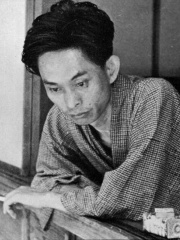
5. Yasunari Kawabata (1899 - 1972)
With an HPI of 79.61, Yasunari Kawabata is the 5th most famous Japanese Writer. His biography has been translated into 110 different languages.
Yasunari/Kōsei Kawabata (川端 康成, Kawabata Yasunari/Kōsei; Japanese pronunciation: [ka.wa.ba.ta (|) ja.sɯꜜ.na.ɾʲi, -koꜜː.sei, -seː], 11 June 1899 – 16 April 1972) was a Japanese novelist and short story writer whose spare, lyrical, subtly-shaded prose works won him the 1968 Nobel Prize in Literature, the first Japanese author to receive the award. His works have enjoyed broad international appeal and are still widely read.

6. Murasaki Shikibu (973 - 1014)
With an HPI of 78.63, Murasaki Shikibu is the 6th most famous Japanese Writer. Her biography has been translated into 141 different languages.
Murasaki Shikibu (紫式部; [mɯ.ɾa.sa.kʲi ɕi̥.kiꜜ.bɯ, -ɕi̥ꜜ.kʲi-], c. 973 – c. 1014 or 1025), or Shijo (紫女; [ɕiꜜ.(d)ʑo], lit. 'Lady Murasaki'), was a Japanese novelist, poet and lady-in-waiting at the Imperial court in the Heian period. She was best known as the author of The Tale of Genji, widely considered to be one of the world's first novels, written in Japanese between about 1000 and 1012. Murasaki Shikibu is a descriptive name; her personal name is unknown, but she may have been Fujiwara no Kaoruko (藤原香子), who was mentioned in a 1007 court diary as an imperial lady-in-waiting. Heian women were traditionally excluded from learning Chinese, the written language of government, but Murasaki, raised in her erudite father's household, showed a precocious aptitude for the Chinese classics and managed to acquire fluency. She married in her mid-to-late twenties and gave birth to a daughter, Daini no Sanmi. Her husband died after two years of marriage. It is uncertain when she began to write The Tale of Genji, but it was probably while she was married or shortly after she was widowed. In about 1005, she was invited to serve as a lady-in-waiting to Empress Shōshi at the Imperial court by Fujiwara no Michinaga, probably because of her reputation as a writer. She continued to write during her service, adding scenes from court life to her work. After five or six years, she left court and retired with Shōshi to the Lake Biwa region. Scholars differ on the year of her death; although most agree on 1014, others have suggested she was alive in 1025. Murasaki wrote The Diary of Lady Murasaki; a volume of poetry; as well as The Tale of Genji. Within a decade of its completion, Genji was distributed throughout the provinces; within a century it was recognized as a classic of Japanese literature and had become a subject of scholarly criticism. Between 1925 and 1933, The Tale of Genji was published in English. Scholars continue to recognize the importance of her work, which reflects Heian court society at its peak. Since the 13th century her works have been illustrated by Japanese artists and well-known ukiyo-e woodblock masters.

7. Osamu Dazai (1909 - 1948)
With an HPI of 76.80, Osamu Dazai is the 7th most famous Japanese Writer. His biography has been translated into 53 different languages.
Shūji Tsushima (津島 修治, Tsushima Shūji; 19 June 1909 – 13 June 1948), known by his pen name Osamu Dazai (太宰 治, Dazai Osamu), was a Japanese novelist and author. A number of his most popular works, such as The Setting Sun (斜陽, Shayō) and No Longer Human (人間失格, Ningen Shikkaku), are considered modern classics. His influences include Ryūnosuke Akutagawa, Murasaki Shikibu and Fyodor Dostoevsky. His last book, No Longer Human, is his most popular work outside of Japan. Another pseudonym he used was Shunpei Kuroki (黒木 舜平), for the book Illusion of the Cliffs (断崖の錯覚, Dangai no Sakkaku).

8. Kenzaburō Ōe (1935 - 2023)
With an HPI of 76.20, Kenzaburō Ōe is the 8th most famous Japanese Writer. His biography has been translated into 95 different languages.
Kenzaburō Ōe (大江 健三郎, Ōe Kenzaburō; 31 January 1935 – 3 March 2023) was a Japanese writer and a major figure in contemporary Japanese literature. His novels, short stories and essays, strongly influenced by French and American literature and literary theory, deal with political, social and philosophical issues, including nuclear weapons, nuclear power, social non-conformism, and existentialism. Ōe was awarded the 1994 Nobel Prize in Literature for creating "an imagined world, where life and myth condense to form a disconcerting picture of the human predicament today".

9. Ryūnosuke Akutagawa (1892 - 1927)
With an HPI of 75.67, Ryūnosuke Akutagawa is the 9th most famous Japanese Writer. His biography has been translated into 70 different languages.
Ryūnosuke Akutagawa (芥川 龍之介, Akutagawa Ryūnosuke; Japanese pronunciation: [ɾʲɯː.no.sɯ̥.ke], 1 March 1892 – 24 July 1927), art name Chōkōdō Shujin (澄江堂主人), was a Japanese writer active in the Taishō period in Japan. He is regarded as the "father of the Japanese short story", and Japan's premier literary award, the Akutagawa Prize, is named after him. He took his own life at the age of 35 through an overdose of barbital.
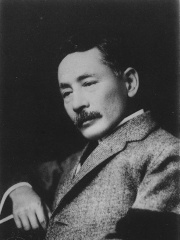
10. Natsume Sōseki (1867 - 1916)
With an HPI of 72.84, Natsume Sōseki is the 10th most famous Japanese Writer. His biography has been translated into 53 different languages.
Natsume Sōseki (; Japanese: 夏目 漱石; born Natsume Kinnosuke (夏目 金之助); 9 February 1867 – 9 December 1916) was a Japanese novelist, poet, and scholar. He is considered one of the greatest writers in modern Japanese history and is often called the first modern novelist of Japan. Sōseki's fiction explored themes of individualism, loneliness, and the conflict between traditional Japanese values and the rapid Westernization of the Meiji era. His major works include I Am a Cat (1905), Botchan (1906), Sanshirō (1908), Kokoro (1914), and his unfinished final novel Light and Dark (1916). Born on the cusp of the Meiji Restoration, Sōseki had a turbulent childhood, having been given up for adoption twice. He graduated from Tokyo Imperial University and became a scholar of English literature. In 1900, he was sent by the Japanese government to study in London, where he spent two miserable years marked by poverty, racial alienation, and a severe nervous breakdown. Upon his return to Japan, he succeeded Lafcadio Hearn as a lecturer in English literature at Tokyo Imperial University. In 1905, he achieved fame with the publication of the satirical novel I Am a Cat. This success prompted him to begin a prolific writing career, and in 1907, he resigned from his university post to become a full-time author for the Asahi Shimbun newspaper, a move that marked the birth of the professional artist in modern Japan. For the rest of his life, Sōseki published a novel a year while also writing poetry and literary criticism. His work is characterized by its psychological depth, its blend of humor and pessimism, and its exploration of the human ego. Throughout his adult life, he suffered from severe stomach ulcers and recurring bouts of mental illness, including paranoid delusions, which deeply affected his work and personal life. Sōseki died from complications of his stomach condition in 1916 at the age of 49, leaving his final novel, Light and Dark, unfinished. His influence on Japanese literature is profound, and he remains one of the country's most beloved and widely read authors. His portrait appeared on the 1,000-yen banknote from 1984 to 2004.
People
Pantheon has 130 people classified as Japanese writers born between 662 and 1986. Of these 130, 34 (26.15%) of them are still alive today. The most famous living Japanese writers include Haruki Murakami, Kazuo Ishiguro, and Ryū Murakami. The most famous deceased Japanese writers include Matsuo Bashō, Miyamoto Musashi, and Yukio Mishima. As of April 2024, 10 new Japanese writers have been added to Pantheon including Ryukishi07, Chiaki J. Konaka, and Hajime Kanzaka.
Living Japanese Writers
Go to all RankingsHaruki Murakami
1949 - Present
HPI: 80.40
Kazuo Ishiguro
1954 - Present
HPI: 71.66
Ryū Murakami
1952 - Present
HPI: 64.41
Junji Ito
1963 - Present
HPI: 64.12
Keigo Higashino
1958 - Present
HPI: 62.17
Banana Yoshimoto
1964 - Present
HPI: 61.72
Yasutaka Tsutsui
1934 - Present
HPI: 59.75
Hiromi Kawakami
1958 - Present
HPI: 59.35
Natsuo Kirino
1951 - Present
HPI: 59.30
Yoko Tawada
1960 - Present
HPI: 57.24
Koji Suzuki
1957 - Present
HPI: 57.11
Yōko Ogawa
1962 - Present
HPI: 56.93
Deceased Japanese Writers
Go to all RankingsMatsuo Bashō
1644 - 1694
HPI: 85.14
Miyamoto Musashi
1584 - 1645
HPI: 81.76
Yukio Mishima
1925 - 1970
HPI: 79.92
Yasunari Kawabata
1899 - 1972
HPI: 79.61
Murasaki Shikibu
973 - 1014
HPI: 78.63
Osamu Dazai
1909 - 1948
HPI: 76.80
Kenzaburō Ōe
1935 - 2023
HPI: 76.20
Ryūnosuke Akutagawa
1892 - 1927
HPI: 75.67
Natsume Sōseki
1867 - 1916
HPI: 72.84
Sei Shōnagon
966 - 1025
HPI: 71.53
Kōbō Abe
1924 - 1993
HPI: 71.21
Jun'ichirō Tanizaki
1886 - 1965
HPI: 69.67
Newly Added Japanese Writers (2025)
Go to all RankingsRyukishi07
1973 - Present
HPI: 51.89
Chiaki J. Konaka
1961 - Present
HPI: 49.80
Hajime Kanzaka
1964 - Present
HPI: 48.94
Kinoko Nasu
1973 - Present
HPI: 48.38
Koushun Takami
1969 - Present
HPI: 47.68
Machi Tawara
1962 - Present
HPI: 47.19
Nahoko Uehashi
1962 - Present
HPI: 46.90
Miri Yu
1968 - Present
HPI: 45.64
Noboru Yamaguchi
1972 - 2013
HPI: 45.57
Rie Yasumi
1972 - Present
HPI: 36.37
Overlapping Lives
Which Writers were alive at the same time? This visualization shows the lifespans of the 25 most globally memorable Writers since 1700.

